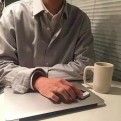英语方位介词的用法
问题描述
- 精选答案
-

1、in/inside 在……里 The students are reading in the classroom.学生们正在教室里读书。
2、into 进入 Throw it into the ifre.把它扔进火里。
3、ouside 在……外面 You can park your car outside our house.你可以把你的汽车停在我们房子外面。
4、out of 从……里出来,侧重于从里向外He walked out of the room and left. 他走出房间并离开了。
5、above 在……斜上方 The water came above our our knees.水没过了我们的膝盖。
6、over 在……正上方;跨越到物体的另一面,将……覆盖He climbed over a wall and ran away. 他爬过墙逃跑了。
7、on 在……上(表面接触) He put a picture on the wall他把一副画贴在了墙上。lders8、onto 到......之上 The child climbed up onto his father's shoulders.这个孩子爬到他爸爸的肩膀上了。9、under 在.......正下方 A policeman is standing under an umbrella.一个警察正站在一把伞下。10、below 在.......斜下方 Skirts must be below the knees.裙子必须要到膝盖以下。11、beneath 紧贴在........的下方 They found the corpse buried beneath a pile of leaves. 他们在一堆树叶下面发现了那具尸体。12、by 在.......旁边 Our house is by the driver. 我们的房子在河旁边13、beside 在.......旁边 Come and sit beside me.来坐在我旁边吧。14、past/by 从......旁边经过 He walked by/past me without speaking.他从我身边走过,话没说一句。15、near/close to 在.......附近 Don't sit near/close to the door.别坐在门口。16、next to 紧挨着...... A close firend of mine sits next to me in the room. 我的一位密友在房间里紧挨着我坐。17、behind 在......的后面 Oliver hid behind a balloon.奥利弗藏在一个气球后面。18、in front of/before 在......外部的前面 He likes to sit in front of me.他喜欢坐在我前面19、in the front of 在......内部的前面,其反义短语为at the back ofThe teacher is in the front of the classroom.老师在教室的前面。
20、around 围绕....... The whole family are sitting around a table.一家人正围绕着桌子坐着。
21、 from 从.....来,强调起点 Has the train from London arrived?从轮渡来的火车到了吗?22、across 横过.......;在......对面 My house is just across the street.我的房子就在大街对面。
23、through 透过,穿过 The burglar got in through the window.窃贼是从窗户进来的。
24、along 沿着 I was walking along the street when I caught sight of a tailor's shop. 我正沿着大街走着,这是我看到一家裁缝铺。
25、away from /off 从某处落下或离开 Keep off the grass. 勿踏草坪。
26、between 在两者之间 There was a fight between the two boys.这两个男孩子打过一次架。
27、among 在三者或三者之间 They hid themselves among the trees.他们躲在森林中。
- 其他回答
-
英语中的方位介词是指用于表示位置、方向或空间关系的介词。在英语语法中,方位介词是一个比较重要的部分,正确使用方位介词可以让我们表达更清晰、更准确的意思。下面是英语方位介词的用法总结:
In 表示“在……之内”、“在……里面”,常用于表示三维空间中的位置关系。 例句:I am in the room.(我在房间里。)
On 表示“在……表面”、“在……上面”,常用于表示二维空间中的位置关系。 例句:The book is on the table.(书在桌子上。)
At 表示“在……位置”、“在……地方”,常用于表示具体的地点。 例句:I am at the office.(我在办公室。)
Under 表示“在……下面”,常用于表示二维空间中的位置关系。 例句:The cat is under the table.(猫在桌子下面。)
Over 表示“在……上面”,常用于表示二维空间中的位置关系。 例句:The airplane is flying over the clouds.(飞机在云层上面飞行。)
Above 表示“在……上面”,常用于表示三维空间中的位置关系。 例句:The bird is flying above the tree.(鸟在树上面飞行。)
Below 表示“在……下面”,常用于表示三维空间中的位置关系。 例句:The fish is swimming below the surface of the water.(鱼在水面下游泳。)
Beside 表示“在……旁边”,常用于表示二维空间中的位置关系。 例句:The car is parked beside the house.(车停在房子旁边。)
Next to 表示“在……旁边”,常用于表示三维空间中的位置关系。 例句:My seat is next to the window.(我的座位在窗户旁边。)
Between 表示“在……之间”,常用于表示两个物体或位置之间的关系。 例句:The book is between the two cups.(书在两个杯子之间。)
总之,英语方位介词的正确使用可以让我们表达更加精确、清晰的意思














